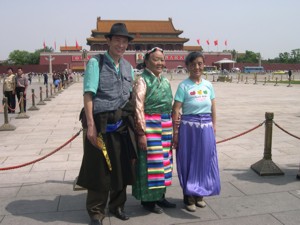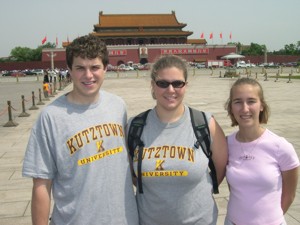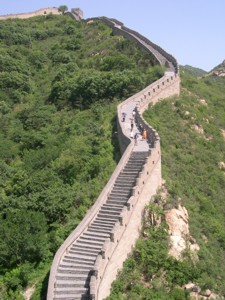
 On several days that I wasn't
teaching in Beijing, we went to visit the typical tourist
sites in and
around Beijing. To get to the center of Beijing, we rode the
train. As you can see from these photos, it can be pretty busy,
but was actually less crowded than some eastern European city trains
I've been on.
On several days that I wasn't
teaching in Beijing, we went to visit the typical tourist
sites in and
around Beijing. To get to the center of Beijing, we rode the
train. As you can see from these photos, it can be pretty busy,
but was actually less crowded than some eastern European city trains
I've been on. Tiananmen Square
 Our first stop was Tiananmen
Square (Gate of Heavenly Peace). It's a nice square, with the old
city wall gate on one end, a couple of big government buildings on the
sides, and then the Forbidden Palace on the other end. Chairman
Mao Zedong's tomb is in the background here, as well as a nice statue
paying tribute to the working people of China. We waited in a
long line and got to walk past Chairman Mao's preserved body inside the
Maosoleum. I'd expected seeing Chairman Mao's body to be
borderline comparable with visiting a Ripley's Museum, but actually
found myself pondering what a huge impact someone would have to have on
a nation to inspire them to preserve their body like this decades
later.
Our first stop was Tiananmen
Square (Gate of Heavenly Peace). It's a nice square, with the old
city wall gate on one end, a couple of big government buildings on the
sides, and then the Forbidden Palace on the other end. Chairman
Mao Zedong's tomb is in the background here, as well as a nice statue
paying tribute to the working people of China. We waited in a
long line and got to walk past Chairman Mao's preserved body inside the
Maosoleum. I'd expected seeing Chairman Mao's body to be
borderline comparable with visiting a Ripley's Museum, but actually
found myself pondering what a huge impact someone would have to have on
a nation to inspire them to preserve their body like this decades
later.  Zach, Kristen, and Lisa posing in
front of the entrance gate in the old city wall. I often wonder
why I, like so many tourists, insist on taking posed photos like this
with famous landmarks in the background.
Zach, Kristen, and Lisa posing in
front of the entrance gate in the old city wall. I often wonder
why I, like so many tourists, insist on taking posed photos like this
with famous landmarks in the background. Is it to prove we were there?
Is it to prove that the landmark actually exists?

 We
met a group from Tibet there. As you can see, they wore some
unusual clothing, so they caught my eye and I'm not shy about talking
to strangers (i.e., friends I have not yet met), so ... here we are
hanging around with some Tibetans.
We
met a group from Tibet there. As you can see, they wore some
unusual clothing, so they caught my eye and I'm not shy about talking
to strangers (i.e., friends I have not yet met), so ... here we are
hanging around with some Tibetans.  Tibet
is known as the Xizang Autonomous Region. China has 23
Provinces, plus 4 municipalities, plus five Autonomous Regions
(also here).
Provinces are like provinces or states in any other country - they are
smaller governing bodies that are ultimately under the jurisdiction of
the federal government. Municipalities are large cities that
count as a state unto themselves - like Bremen in Germany. The
autonomous regions are, in theory, self governing, and so might be akin
to the Native
American Nations in the
United States.
Tibet
is known as the Xizang Autonomous Region. China has 23
Provinces, plus 4 municipalities, plus five Autonomous Regions
(also here).
Provinces are like provinces or states in any other country - they are
smaller governing bodies that are ultimately under the jurisdiction of
the federal government. Municipalities are large cities that
count as a state unto themselves - like Bremen in Germany. The
autonomous regions are, in theory, self governing, and so might be akin
to the Native
American Nations in the
United States. Forbidden City

 The
entrance to the Forbidden City
(a.k.a., Palace Museum) is at the end of Tiananmen Square and boasts a
nice big portrait of Chairman Mao. This was the home of the Emporer
during the Ming and Qing dynasties (i.e., starting around 1400).
It's remarkable and beautiful. Fei HongCia had spent some time as
a tour guide once, so she tried to fill us in with all the little
stories behind the place. It can be pretty overwhelming if you're
not at all familiar with Chinese history, but if you don't know
something, then you can always learn!
The
entrance to the Forbidden City
(a.k.a., Palace Museum) is at the end of Tiananmen Square and boasts a
nice big portrait of Chairman Mao. This was the home of the Emporer
during the Ming and Qing dynasties (i.e., starting around 1400).
It's remarkable and beautiful. Fei HongCia had spent some time as
a tour guide once, so she tried to fill us in with all the little
stories behind the place. It can be pretty overwhelming if you're
not at all familiar with Chinese history, but if you don't know
something, then you can always learn!Great Wall at Badaling

 This
is one of the most cleaned-up sections of the Great Wall,
and
definitely very touristy. I didn't mind there being other people
on the wall with me, but people seeking a solitary walk along the wall
might choose to go to one of the other
Great Wall access points.
As you can see, the wall was
constructed along the ridge line for maximum security. Imagine
hauling giant blocks of granite up to the top of the hill without the
use of mechanized equipment all day, every day, for your
lifetime. That's what I thought about, anyway. Sure, the
day's work would be tough, but what did the workers do in their
evenings, etc.? I'm sure the broke the work down into smaller
projects, so I wonder if there was griping about how some people always
seem to get the easier jobs, or if there was a sense of pride when
completing something like a guard tower. It made me think of my
days cooking in a restaurant - the work was not particularly inspiring,
so we found solace and significance in small day-to-day things.
The other thing I thought about was what it'd be like to be a sentry
walking the wall on some cold winter night.
This
is one of the most cleaned-up sections of the Great Wall,
and
definitely very touristy. I didn't mind there being other people
on the wall with me, but people seeking a solitary walk along the wall
might choose to go to one of the other
Great Wall access points.
As you can see, the wall was
constructed along the ridge line for maximum security. Imagine
hauling giant blocks of granite up to the top of the hill without the
use of mechanized equipment all day, every day, for your
lifetime. That's what I thought about, anyway. Sure, the
day's work would be tough, but what did the workers do in their
evenings, etc.? I'm sure the broke the work down into smaller
projects, so I wonder if there was griping about how some people always
seem to get the easier jobs, or if there was a sense of pride when
completing something like a guard tower. It made me think of my
days cooking in a restaurant - the work was not particularly inspiring,
so we found solace and significance in small day-to-day things.
The other thing I thought about was what it'd be like to be a sentry
walking the wall on some cold winter night.  The
hike from the access point is up hill, but it's downhill going the
other way, so the round trip is just 50% uphill. (I know that
sounds obvious, but people seem to forget that kind of thing about
life, so ...)
The
hike from the access point is up hill, but it's downhill going the
other way, so the round trip is just 50% uphill. (I know that
sounds obvious, but people seem to forget that kind of thing about
life, so ...)There are two schools of though concerning water. (1) The cheap school (i.e., mine) says haul it all up yourself - you'll save a few yuan and you'll get a little extra exercise hauling the water up the hill. (2) The other school of thought argues that, "yeah, the price of water sold in bottles by folks at the top of the hill is very expensive compared to what you can get in Beijing, but that's the price of luxury and it's comparable to the price of bottled water in America anyway, so why be a cheapskate?" Whatever school you choose, be sure to drink a lot of water!!

 Some
stretches are fairly steep and so provide an excellent stair
workout. The Chinese government installed hand rails along the
sides for safety, which is a good idea because these are stairs that
you definitely do not want to fall down!
Some
stretches are fairly steep and so provide an excellent stair
workout. The Chinese government installed hand rails along the
sides for safety, which is a good idea because these are stairs that
you definitely do not want to fall down!Note the granite outcrop beneath the wall in the picture on the right. There were several places where the wall was built around such large outcrops so that they are engulfed like a fly in amber. There are a few studies of the granite (e.g., Wu et al., 2000; Wang and Zhang, 2001) indicate it originally crystallized "deep" within the earth roughly 130 million years ago, but was then uplifted to the surface quickly fairly recently by geological standards (6 million years ago).

 Stairmaster 1400!
Stairmaster 1400! 
 Some obligatory photos with the
landmark in the background. Fei HongCai and Wang BingTing were
excellent guides. With Wang BingTing's eternally positive
attitude, the trip could only be a happy one!
Some obligatory photos with the
landmark in the background. Fei HongCai and Wang BingTing were
excellent guides. With Wang BingTing's eternally positive
attitude, the trip could only be a happy one! The Chinese are trying to be
sensitive to the impacts of people on the environment. Many of
the students I've met are environmental geologists who are just as avid
about protecting the environment as anyone I've met anywhere else in
the world.
The Chinese are trying to be
sensitive to the impacts of people on the environment. Many of
the students I've met are environmental geologists who are just as avid
about protecting the environment as anyone I've met anywhere else in
the world. Summer Palace

 Have you ever had a teacher who
makes a lesson out of everything? Well, then you have a good
idea of what it's like to travel with me! Totally annoying, I'm
sure, but good for you! There were certainly some beautiful
buildings and impressive views at the Summer Palace, but I liked the
big limestone blocks, too. These are very large blocks shipped in
from somewhere to the south (without the help of modern machines, of
course). I was impressed by the importance of fracture
permeability (and subsequent dissolution channels) on fluid flow
through massive limestones like this.
Have you ever had a teacher who
makes a lesson out of everything? Well, then you have a good
idea of what it's like to travel with me! Totally annoying, I'm
sure, but good for you! There were certainly some beautiful
buildings and impressive views at the Summer Palace, but I liked the
big limestone blocks, too. These are very large blocks shipped in
from somewhere to the south (without the help of modern machines, of
course). I was impressed by the importance of fracture
permeability (and subsequent dissolution channels) on fluid flow
through massive limestones like this.  ... and the obligatory landmark
photo...
... and the obligatory landmark
photo...
